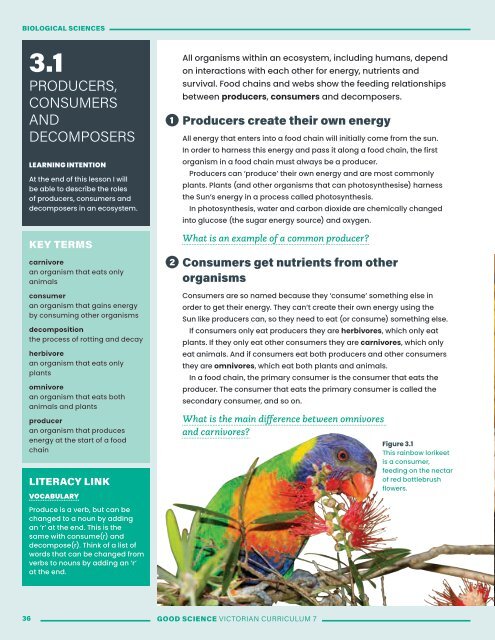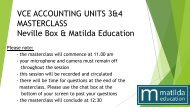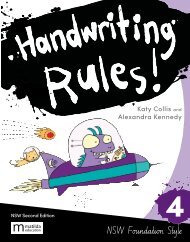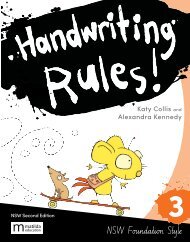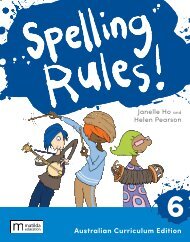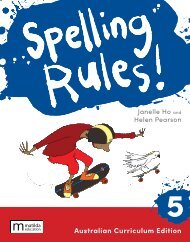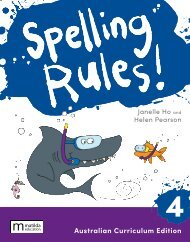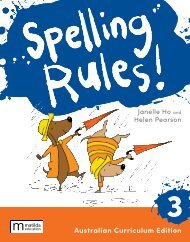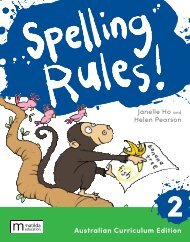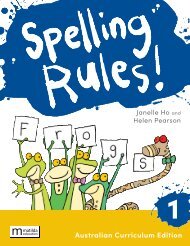Good Science Victorian Curriculum Year 7
Digital sample of Matilda's newest publication, Good Science Victorian Curriculum Year, authored by Emma Craven and Aaron Elias. For more information visit www.matildaeducation.com.au or email Katrina Tucker, katrinatucker@matildaed.com.au
Digital sample of Matilda's newest publication, Good Science Victorian Curriculum Year, authored by Emma Craven and Aaron Elias. For more information visit www.matildaeducation.com.au or email Katrina Tucker, katrinatucker@matildaed.com.au
Create successful ePaper yourself
Turn your PDF publications into a flip-book with our unique Google optimized e-Paper software.
BIOLOGICAL SCIENCES<br />
3.1<br />
PRODUCERS,<br />
CONSUMERS<br />
AND<br />
DECOMPOSERS<br />
LEARNING INTENTION<br />
At the end of this lesson I will<br />
be able to describe the roles<br />
of producers, consumers and<br />
decomposers in an ecosystem.<br />
KEY TERMS<br />
carnivore<br />
an organism that eats only<br />
animals<br />
consumer<br />
an organism that gains energy<br />
by consuming other organisms<br />
decomposition<br />
the process of rotting and decay<br />
herbivore<br />
an organism that eats only<br />
plants<br />
omnivore<br />
an organism that eats both<br />
animals and plants<br />
producer<br />
an organism that produces<br />
energy at the start of a food<br />
chain<br />
LITERACY LINK<br />
VOCABULARY<br />
Produce is a verb, but can be<br />
changed to a noun by adding<br />
an ‘r’ at the end. This is the<br />
same with consume(r) and<br />
decompose(r). Think of a list of<br />
words that can be changed from<br />
verbs to nouns by adding an ‘r’<br />
at the end.<br />
1<br />
2<br />
All organisms within an ecosystem, including humans, depend<br />
on interactions with each other for energy, nutrients and<br />
survival. Food chains and webs show the feeding relationships<br />
between producers, consumers and decomposers.<br />
Producers create their own energy<br />
All energy that enters into a food chain will initially come from the sun.<br />
In order to harness this energy and pass it along a food chain, the first<br />
organism in a food chain must always be a producer.<br />
Producers can ‘produce’ their own energy and are most commonly<br />
plants. Plants (and other organisms that can photosynthesise) harness<br />
the Sun’s energy in a process called photosynthesis.<br />
In photosynthesis, water and carbon dioxide are chemically changed<br />
into glucose (the sugar energy source) and oxygen.<br />
What is an example of a common producer?<br />
Consumers get nutrients from other<br />
organisms<br />
Consumers are so named because they ‘consume’ something else in<br />
order to get their energy. They can’t create their own energy using the<br />
Sun like producers can, so they need to eat (or consume) something else.<br />
If consumers only eat producers they are herbivores, which only eat<br />
plants. If they only eat other consumers they are carnivores, which only<br />
eat animals. And if consumers eat both producers and other consumers<br />
they are omnivores, which eat both plants and animals.<br />
In a food chain, the primary consumer is the consumer that eats the<br />
producer. The consumer that eats the primary consumer is called the<br />
secondary consumer, and so on.<br />
What is the main difference between omnivores<br />
and carnivores?<br />
Figure 3.1<br />
This rainbow lorikeet<br />
is a consumer,<br />
feeding on the nectar<br />
of red bottlebrush<br />
flowers.<br />
36 GOOD SCIENCE VICTORIAN CURRICULUM 7


